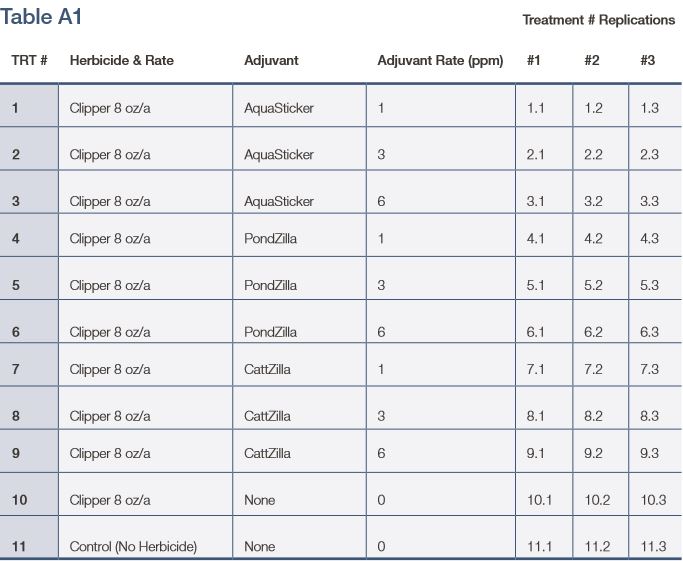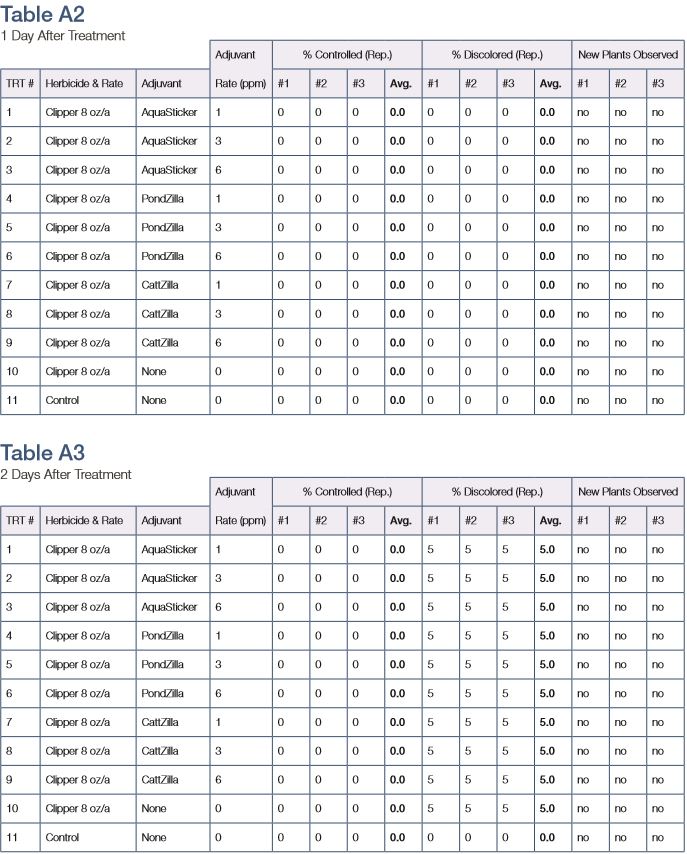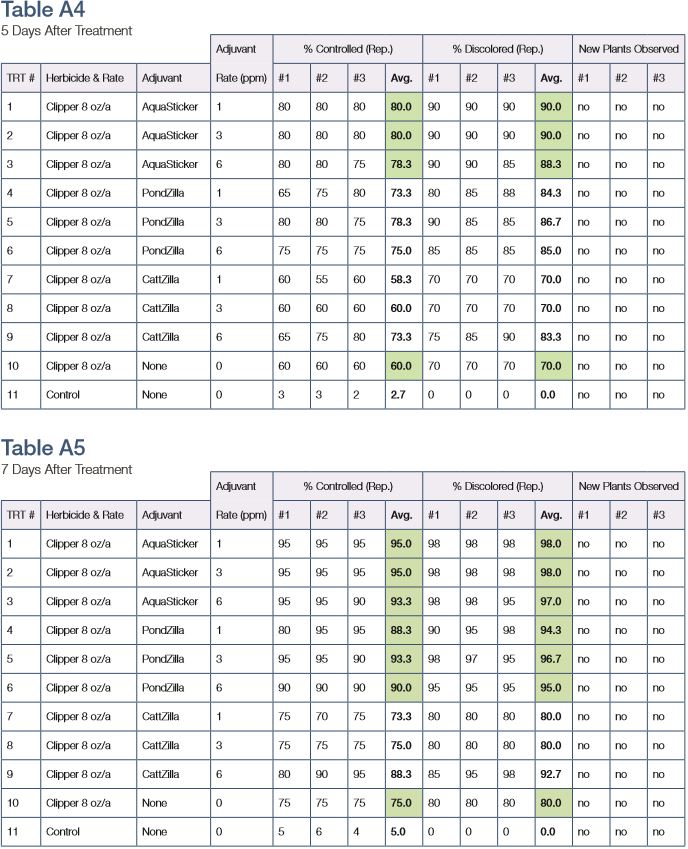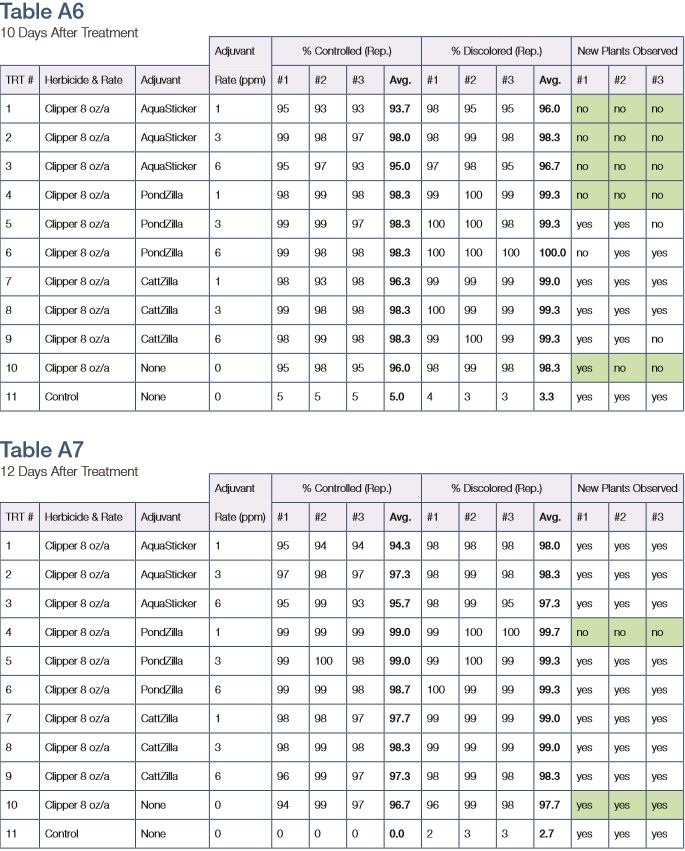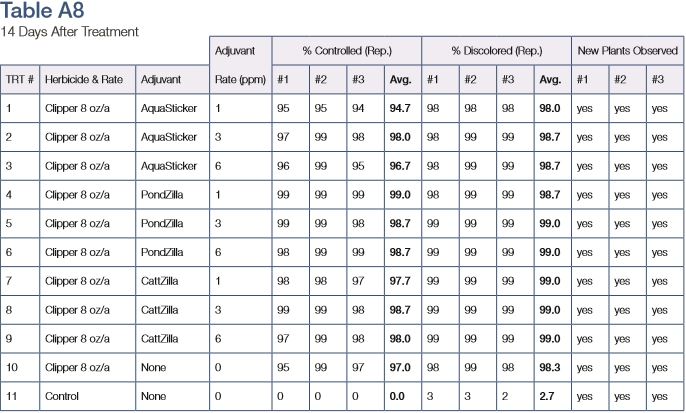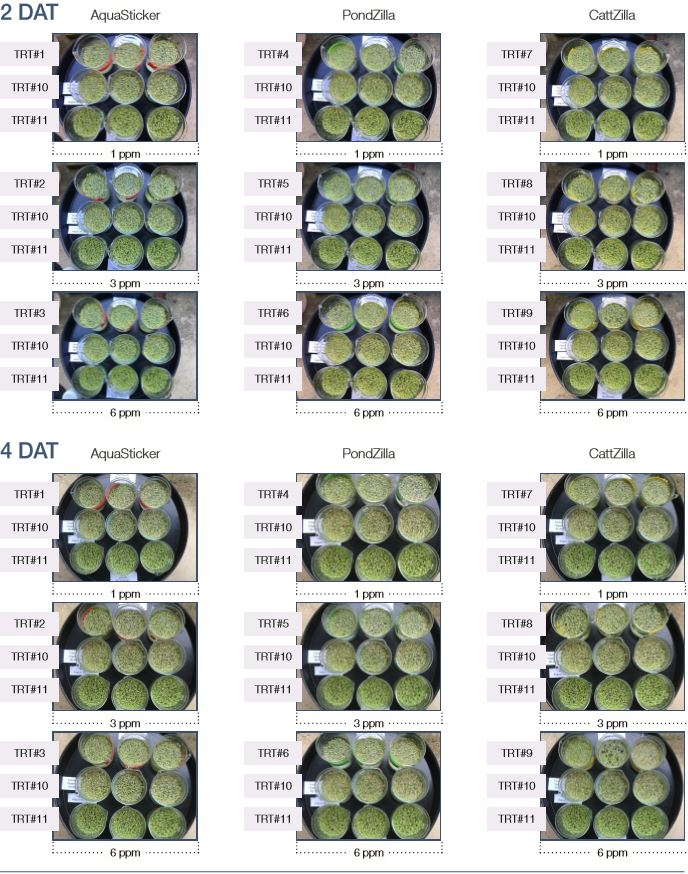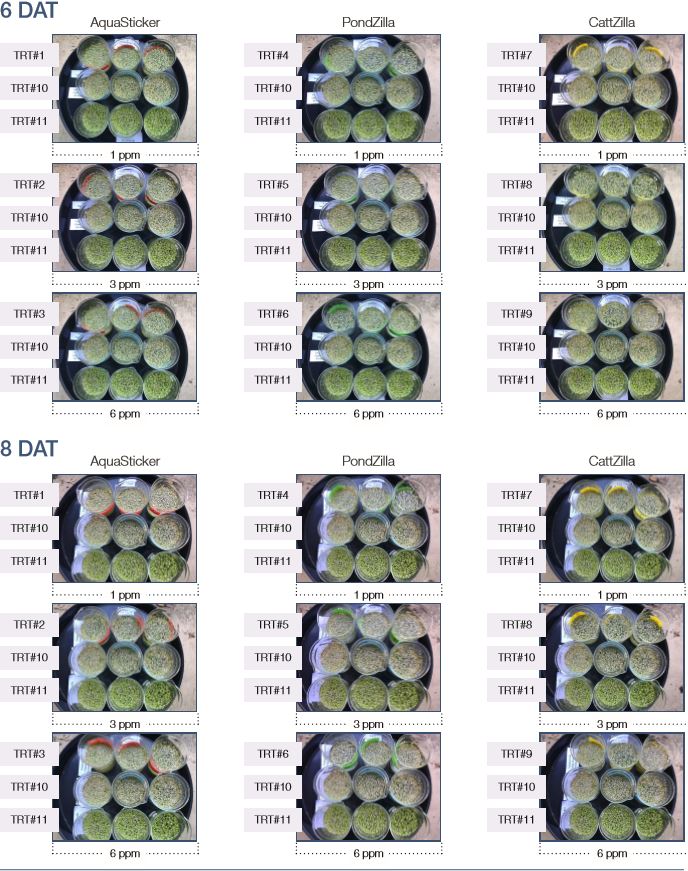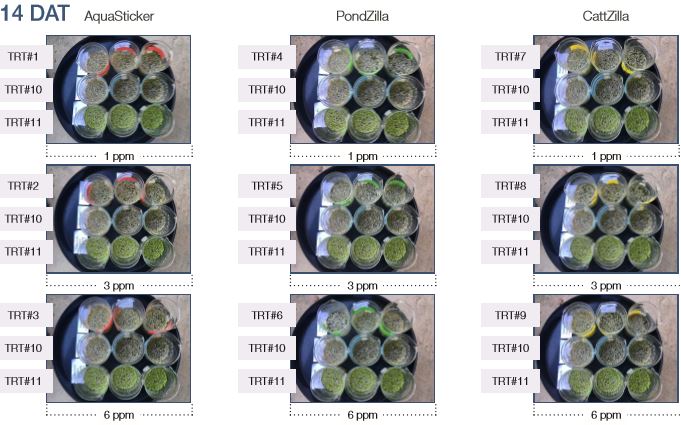Biocatalyst Study
by Dr. Charles Webber, Deborah Lee, and Michael Frett of Natural Lake Biosciences Laboratories
Research was conducted to determine if Natural Lake Biosciences’ biocatalysts products (AquaSticker, PondZilla, and CattZilla) can improve response time and control of duckweed when added to Clipper herbicide treatments and to determine which product would be the most effective.

Abstract
Duckweeds (Lemna spp.) are small, free floating aquatic plants. The plants have one to three leaves of one sixteenth- to one eight-inch length and a single root. Duckweed is often found growing in dense colonies in slow moving or quiescent ponds, lakes, marshes, and streams. Excessive duckweed growth can lead to oxygen depletion, fish kills, and other negative impacts over time. Clipper© (flumioxazin 51%) is a contact herbicide commonly used for controlling duckweed and other floating aquatic plants. Contact herbicides each have a unique exposure time and concentration relationship. Many factors, including sunlight, pH, and water current, can affect this relationship and impact treatment results.
Research was conducted to determine if Natural Lake Biosciences’ biocatalysts products (AquaSticker, PondZilla, and CattZilla) can improve response time and control of duckweed when added to Clipper herbicide treatments and to determine which product would be the most effective. Clipper (flumioxazin 51%) was applied at 8 oz per surface acre in combination with either of three different adjuvants (AquaSticker, PondZilla, and CattZilla) at three different adjuvant rates (1, 3, and 6 ppm). Clipper was also was applied without an adjuvant (Treatment #10). The study included an untreated control (no herbicide, no adjuvants) (Treatment #11).
There were three replications of each treatment. Duckweed discoloration was observed at 2 Days After Treatment (DAT) (visual ratings) and 4 DAT (photos). Significant duckweed control was recorded at 5 DAT (visual ratings) and 6 DAT (photos). In general, the addition of Natural Lake Biosciences’ biocatalysts increased duckweed control compared to Clipper without adjuvants (TRT#10) at 5 DAT, with corresponding difference in discoloration.
It was observed that duckweed control at 10 DAT averaged 93.7% or greater across all treatments receiving Clipper, irrespective of the adjuvants or application rates (1, 3, and 6 ppm). At 10 DAT, duckweed treated with AquaSticker was the only test observed with no regrowth regardless of application rates. This study suggests that Natural Lake Biosciences’ biocatalysts may be used to improve control of duckweed over Clipper herbicide alone.
Introduction
Duckweeds (Lemna spp.) are small, free floating aquatic plants. The plants have 1 to 3 leaves of one sixteenth- to one eighth-inch length and a single root. Duckweed is often found growing in dense colonies in slow moving or quiescent ponds, lakes, marshes, and streams. Excessive duckweed growth can lead to oxygen depletion, fish kills, and other negative impacts over time (Parr et al., 2002). Herbicide applicators consider these species some of the most difficult aquatic plants to control (Turnage, 2018).
Clipper© (flumioxazin 51%) was applied at 8 oz/ac in combination with either of the three different adjuvants (AquaSticker, PondZilla, and CattZilla) at three different adjuvant rates (1, 3, and 6 ppm). Clipper was also applied without an adjuvant (Treatment #10). The study included an untreated control (no herbicide, no adjuvants) (Treatment #11). There were three replications of each treatment. The target aquatic plant was duckweed (Lemma minor L.), also called common duckweed or lesser duckweed.
Spray Date: August 26,2019
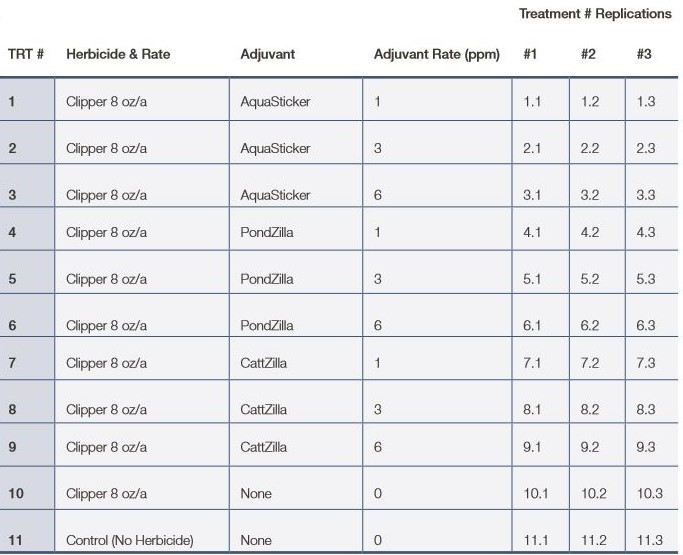
Material and Methods
The duckweed was raised in 5 gal (18.93 L) containers using domestic water (Jenks, OK) treated with Aqueon Water Conditioner (5401 W. Oakwood Park Dr., Franklin, WI 53132, aqueonproducts.com). The water was treated at least three days prior to adding the duckweed for reproduction in the 5 gal containers. Seven days prior to spraying the treatments, duckweed was established in 400 mL beakers with treated water up to the 300 mL level. Duckweed was added to each beaker to provide uniform surface coverage of the beaker water surface. Prior to spraying on August 26, 2019, water was added up to the 300 mL level to compensate for any water loss due to evaporation or plant use.
The Aquafix Adjuvant Study was conducted on August 26, 2019. The experimental treatments were applied using a CO2 pressurized backpack sprayer equipped with an XR8002VS nozzle (extended range, 80° Angle, 0.2 gpm, VisiFlo stainless steel) at 40 psi, 3 mph, and 20 gpa. The nozzle height was 30 inches above the duckweed. Twoliter plastic containers were used for each individual spray treatment. The temperature during spraying was 93.4 to 96.5°F with relative humidity from 59 to 61%. There was no wind at the time of spraying. Visual data (% Control and % Discoloration) was collected at 1 day after treatment (1 DAT) (Aug. 27, 2019), 2 DAT (Aug. 28, 2019), 5 DAT (Aug. 31, 2019), 7 DAT (Sept. 2, 2019), 10 DAT (Sept. 5, 2019), 12 DAT (Sept. 7, 2019), and 14 DAT (Sept. 9, 2019) (see Table A1). Photos were taken on 2 DAT (Aug. 28, 2019), 4 DAT (Aug. 30, 2019), 6 DAT (Sept. 1, 2019), 8 DAT (Sept. 3, 2019), 10 DAT (Sept. 5, 2019), 12 DAT (Sept. 7, 2019), and 14 DAT (Sept. 9, 2019) (see Table A1). The data collection was terminated on 14 DAT (Sept. 9, 2019) when all treatments reached their peak control and new plants were being produced in all treated beakers. The data was then analyzed using R statistical analysis software.
Results and Discussion
Duckweed discoloration was observed at 2 DAT (visual ratings) and 4 DAT (photos). Significant (P < 0.05) duckweed control was recorded at 5 DAT (visual ratings) and 6 DAT (photos). In general, the addition of adjuvants increased duckweed control compared to Clipper© without adjuvants (TRT#10) at 5 DAT with corresponding difference in discoloration. At 5 DAT, there was a general decreasing trend for duckweed control, from the highest to the lowest (AquaSticker > PondZilla > CattZilla > TRT#10 No Adjuvant). At 5 DAT, there was not a clear advantage concerning the 1, 3, and 6 ppm impact of duckweed control in connection with either AquaSticker or PondZilla within the adjuvant, but there was a trend with CattZilla, which had a slight increase of duckweed control at the 3 ppm rate compared to the 1 and 6 ppm. R statistical analysis software did show that TRT#1, TRT#2, TRT#3, TRT#5, and TRT#6 were all statistically significant in comparison to TRT#10.
Five Days After Treatment
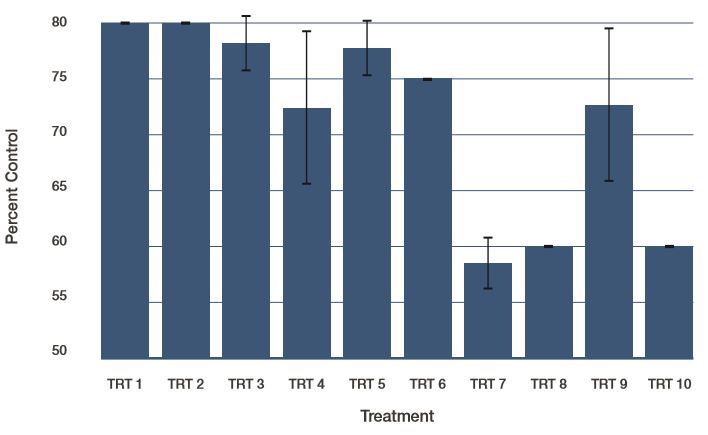
Figure 1
Percent control of the duckweed was measured five days after the initial treatment. Standard deviation between replicates was used to create error bars. TRT#1 (AquaSticker 1 ppm), TRT#2 (AquaSticker 3 ppm), TRT#3 (AquaSticker 6 ppm), TRT#5 (PondZilla 3 ppm), and TRT#6 (PondZilla 6 ppm) were observed to control significantly more duckweed in comparison to TRT#10 (Clipper alone). TRT#4 (PondZilla 1 ppm) and TRT#9 (CattZilla 6 ppm) were also observed to control more duckweed than Clipper alone, but results were not significant. TRT#7 (CattZilla 3 ppm) and TRT#8 (CattZilla 6 ppm) were not observed to control more duckweed in comparison to Clipper alone.
At 7 DAT, duckweed control with AquaSticker or PondZilla was greater than that of the Clipper without adjuvants. Duckweed control during the same period, 7 DAT, tended to be less for CattZilla than either AquaSticker or PondZilla, especially for the 1 and 3 ppm CattZilla rate. The CattZilla 1 and 3 ppm duckweed control is not that different from the adjuvant control (TRT#10: Clipper with no adjuvant), but CattZilla at 6 ppm was greater than the adjuvant control. R statistical analysis software did show that TRT#1, TRT#2, TRT#3, TRT#5, and TRT#6 were all statistically significant in comparison to TRT#10.
Seven Days After Treatment

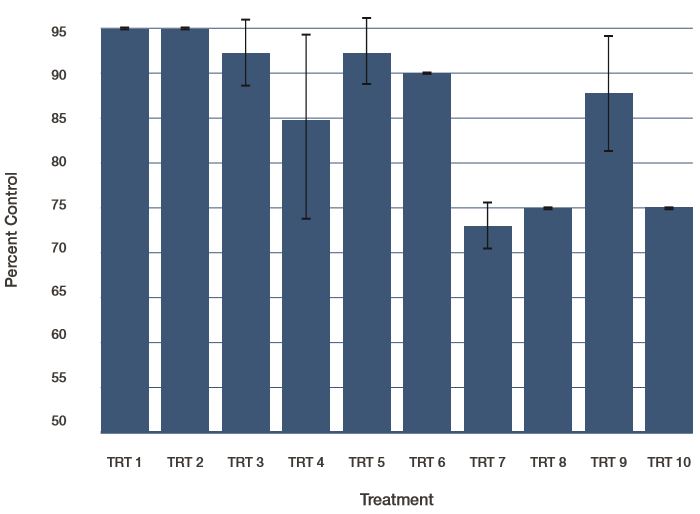
Figure 2
Percent control of the duckweed was measured seven days after the initial treatment. Standard deviation between replicates was used to create error bars. TRT#1 (AquaSticker 1 ppm), TRT#2 (AquaSticker 3 ppm), TRT#3 (AquaSticker 6 ppm), TRT#5 (PondZilla 3 ppm), and TRT#6 (PondZilla 6 ppm) were observed to control significantly more duckweed in comparison to TRT#10 (Clipper alone). TRT#4 (PondZilla 1 ppm) and TRT#9 (CattZilla 6 ppm) were also observed to control more duckweed than Clipper alone, but results were not significant.
At 10 DAT, there were very few duckweed control differences among the three adjuvants (AquaSticker, PondZilla, and CattZilla) or among the three adjuvant rates (1, 3, and 6 ppm) or compared to the Clipper no adjuvant treatment. One exception might include AquaSticker at 1 ppm (93.7% avg. duckweed control) compared to the 3 ppm (98% avg. duckweed control). It was at 7 DAT when new duckweed plants started to appear in TRT#5 through TRT#11 (PondZilla at 3 and 6 ppm, CattZilla at 1, 3, and 6 ppm, Clipper without adjuvants, and no herbicide). No new duckweed plants were observed in TRT#1 through TRT#5 (AquaSticker at 1, 3, and 6ppm; PondZilla at 1ppm).
At 12 DAT, duckweed control was not significantly different from 10 DAT, but new plants were appearing in all treatments except TRT#4 (PondZilla at 1 ppm). The experiment was terminated at 14 DAT when the duckweed control had peaked and all treatments were producing new duckweed plants.
Summary
Early duckweed control (5 DAT, 7 DAT) was greater when the Aquafix adjuvants AquaSticker and PondZilla were applied at 1, 3, and 6 ppm with Clipper© at 8 oz/ac compared to when Clipper was applied without adjuvants. CattZilla at 6 ppm also produced greater duckweed control at 5 DAT and 7 DAT compared to Clipper without adjuvants. It was observed that duckweed control at 10 DAT averaged 93.7% or greater across all treatments receiving Clipper, irrespective of the adjuvants or application rates (1, 3, and 6 ppm). Although there were slight increases in duckweed control from 10 DAT to 12 DAT and 14 DAT, duckweed control basically peaked at 10 DAT. New duckweed plants were observed starting at 10 DAT for PondZilla (3, 6 ppm), CattZilla (1, 3, 6 ppm), Clipper with adjuvants, and the control (no herbicide, no adjuvants). At 12 DAT, the only treatment not developing new plants was PondZilla 1 ppm. At 14 DAT, the experiment was terminated with duckweed control at 94.7% or greater for all treatments receiving Clipper applications and all treatments were producing new duckweed plants.
Future Research
New research investigating a lower rate of Clipper (i.e. 6 oz/ac) may help further determine the comparative differences and advantages among the adjuvants and the adjuvant rates (1, 3, and 6 ppm). Flumioxazin is more rapidly degraded by hydrolysis as pH increases (Katagi 2003, Senseman 2007), therefore, increasing the pH of the beaker water used in the testing to reduce the half-life of the flumioxazin may also help show how comparative differences in response time affect overall control. Also, using more frequent intervals for data collection may show greater separation among adjuvants or the control.
Conclusion
This study suggests that Natural Lake Biosciences’ biocatalysts may be used to improve control of duckweed over Clipper herbicide alone. Treatments receiving Natural Lake Biosciences’ biocatalysts achieved greater control in a shorter period in this study. In addition, treatments receiving Natural Lake Biosciences’ biocatalysts were able to maintain control for longer periods before new growth was observed.
Appendix
